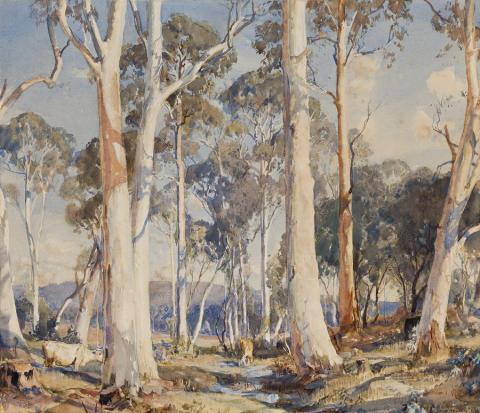AN EARLY SUMMER MORNING AMBLESIDE, 1923
HANS HEYSEN
watercolour on paper
51.0 x 64.0 cm
signed and dated lower right: HANS HEYSEN 1923
Acquired directly from the artist
Thence by descent
Private collection, New South Wales
Hans Heysen and the village of Hahndorf in the Adelaide Hills are almost synonymous. The picturesque Hahndorf near Mt Barker in the Adelaide Hills was named after Captain Dirk Hahn of the ship Zebra, which brought out the Prussian Lutheran families who settled there in 1839. During the First World War the South Australian Government changed many of the German place names, Hahndorf becoming Ambleside, after a town in northwest England. It remained so until 1930. Heysen used both names in his numerous watercolours and oil paintings of the area. Heysen and his wife Sallie moved to Hahndorf in 1908. They lived in rented accommodation before buying the nearby property 'The Cedars' in 1912. It was to be his home for over fifty years.
Heysen rejoiced in the beauty of the area, painting it throughout the changing seasons and times of day - of mists or the brightness of spring, early morning light and the hazy heat of midday, to the gentle light of day's end. The constant throughout his art was the noble gum. Heysen wrote:
'The subtlety of the tree combined with the beauty; the bulk, the solidity of the tree, and the character of its growth... It's wonderful just to watch the combination of characters; sometimes you get a group of gums and you see how they combine, grow into interesting shapes, and suggest various things, ...I had my special trees, and they altered their appearance - the time of the year and the angle of the sun made all the difference. You could paint a tree one day and get all its various facets. And the next day it would be a different tree...'1
Heysen was devoted to the Hahndorf landscape, sometimes peopled, with sheep, or cattle as in An Early Summer Morning, Ambleside 1923. Capturing the landscape surrounding 'The Cedars' it is redolent with the serenity Heysen found here, gently reigned over by the grandeur of white gums. It is a lyrical vision of nature in all her plenitude, painted in a golden period in Heysen's art. His creative achievements were matched by public acclaim. Exhibition sales were extraordinary; and during the twenties he was awarded the Wynne Prize for landscape four times out of a life's total of eight. The art critic for The Age described his 1926 exhibition in Melbourne as '... probably the highest artistic level he has yet reached.'2 Heysen's biographer Colin Thiele wrote of 'an insatiable demand for his pictures from dealers and private clients.'3 An Early Summer Morning, Ambleside did not get as far as the exhibition walls. It was purchased directly from the artist by E. J. Watt in the year it was painted.
1. Thiele, C., Heysen of Hahndorf , David Heysen productions, Adelaide, 2001, p. 147
2. 'Art Notes', Age, Melbourne, 16 November 1926, p. 13
3. Thiele, op. cit., p. 186
DAVID THOMAS
